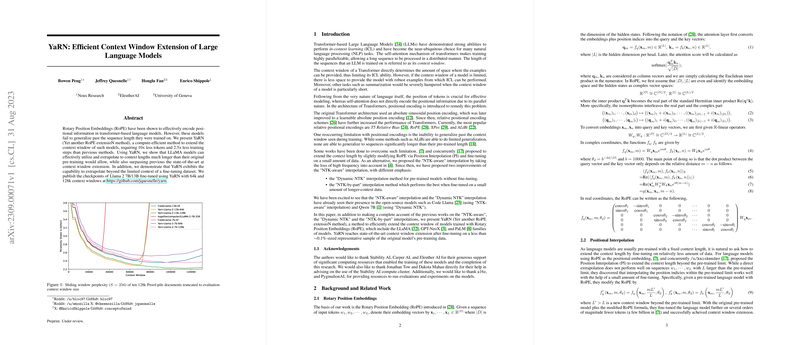YaRN: An Efficient Method for Extending the Context Window of RoPE-Enabled LLMs
Introduction to RoPE and Its Limitations
LLMs have significantly benefited from the introduction of Rotary Position Embeddings (RoPE), which encode positional information more effectively in transformer architectures. While RoPE has been pivotal in enhancing the capabilities of these models, a notable limitation is their failure to generalize to sequence lengths beyond their training confines. Addressing this, we examine the recent development of YaRN (Yet another RoPE extensioN method), a novel approach that proposes a compute-efficient solution to extend the contextual reach of RoPE-enabled LLMs without demanding extensive training resources.
Background on Positional Encoding and Existing Solutions
Positional encoding has evolved through various iterations, moving from absolute to relative schemes, with RoPE emerging as a popular choice due to its ability to manage relative distances effectively. Despite its advantages, extending the context window beyond the pre-trained threshold remained a challenge. Prior efforts, such as Position Interpolation (PI) and "NTK-aware" interpolation, made strides towards solving this issue but were either limited in scalability or demanded substantial fine-tuning resources.
Within this landscape, YaRN emerges as a comprehensive solution that builds upon the foundations of RoPE and earlier interpolation efforts. By incorporating techniques like "NTK-by-parts" and Dynamic Scaling, YaRN presents a method that significantly reduces the necessity for large training datasets and computational steps while effectively extending the context window.
Unveiling YaRN: Methodology and Advantages
YaRN introduces a multi-faceted approach to address the challenges of context window extension. At its core, YaRN distinguishes itself by employing a targeted interpolation method that respects the inherent frequency components of RoPE, unlike the "blind" methods of its predecessors. This nuanced consideration of frequency information ensures that both high and low-frequency details are aptly scaled, preserving the model's ability to discern close and distant relations within the text cohesively.
Additionally, the integration of Dynamic Scaling allows YaRN to adjust the scale factor in real-time during inference, promoting model robustness across varying sequence lengths. This is a leap forward, enabling models to maintain performance without the abrupt degradation observed in previous methods when reaching the pre-trained context limit.
Empirical Validation and Practical Implications
Through exhaustive experimentation with LLaMA among other models, YaRN has proven its prowess in extending context windows far beyond existing benchmarks, doing so with remarkably lower training requirements. Specifically, YaRN brought about state-of-the-art performance in context window extensions with 10x fewer tokens and a 2.5x reduction in training steps compared to its closest competitors. These improvements not only signify a breakthrough in the efficiency of training but also in the applicability of LLMs to tasks involving significantly longer sequences.
Beyond its numerical successes, YaRN's methodological contributions suggest a promising avenue for future research into embedding interpolation and model generalization over extended contexts. It opens the door to more computationally efficient and scalable solutions for managing large sequence lengths - a critical frontier for advancement in natural language processing and understanding.
Looking Ahead: YaRN and the Future of LLMs
YaRN’s introduction represents a pivotal advancement in the manipulation of context windows for LLMs. Its ability to efficiently extend context sizes poses significant implications for both the theoretical understanding and practical utilization of transformer architectures. This approach not only enhances current models' capabilities but also lays foundational knowledge that could inspire future innovations in LLM development. As we continue to explore the boundaries and applications of LLMs, techniques like YaRN will be instrumental in shaping the next generation of AI-driven language understanding and generation.
